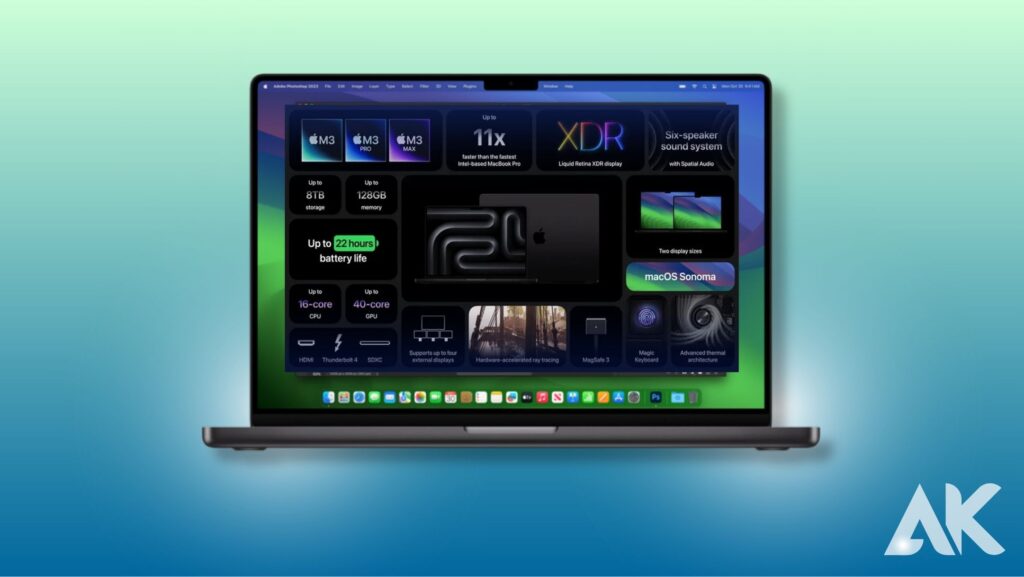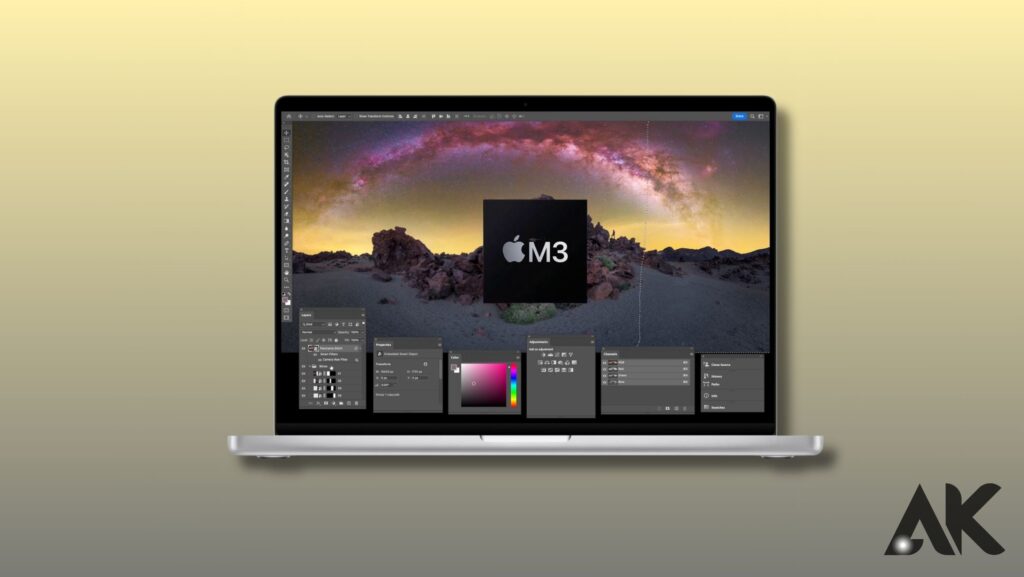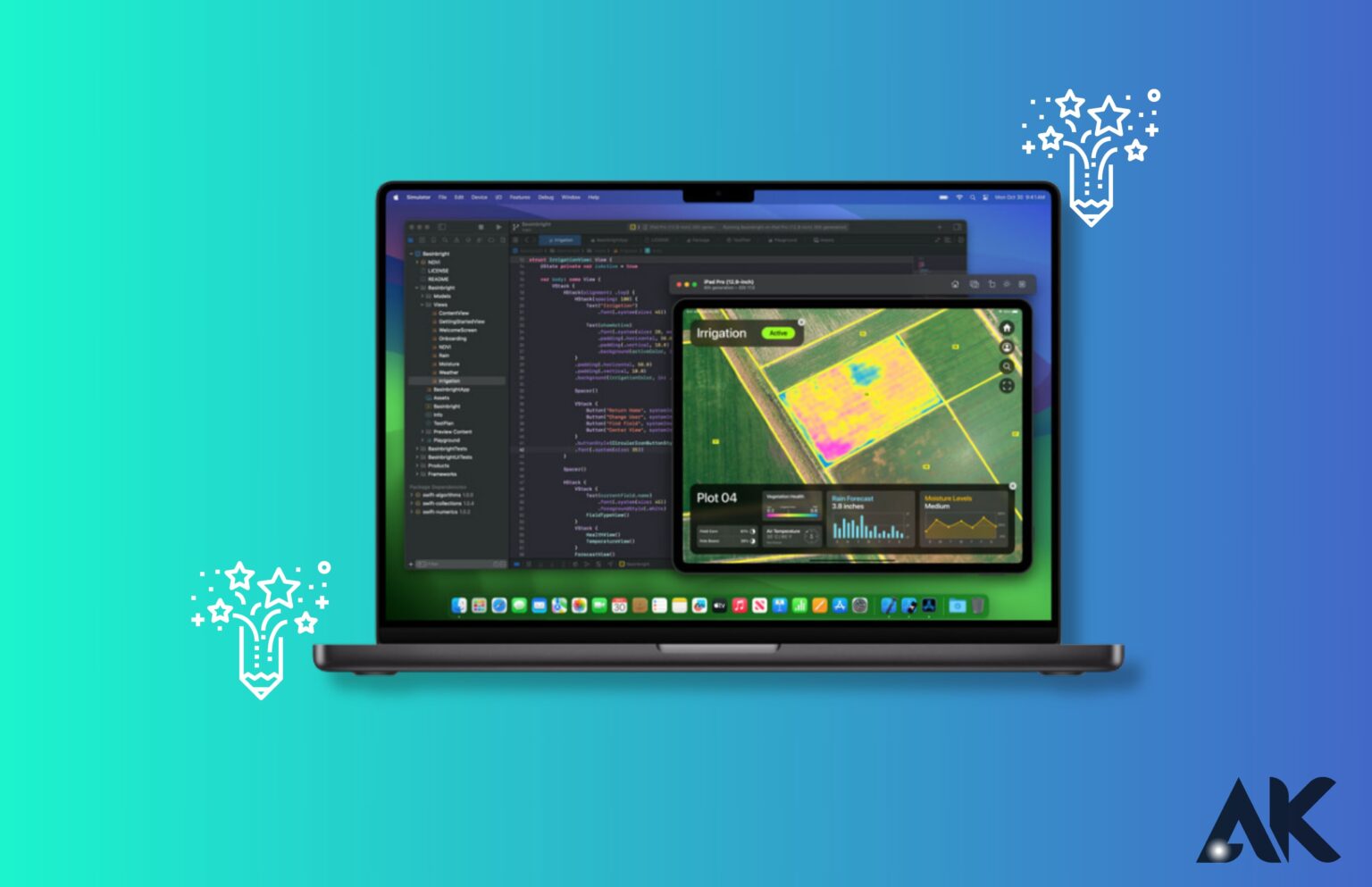The M3 MacBook Pro is a ground-breaking tool that has fundamentally changed how artists realize their ideas. Artists, designers, and content creators may now unleash their creativity like never before with this laptop’s tremendous features and beautiful design. The state-of-the-art technology of the M3 MacBook Pro pushes the limits of performance and economy. Because of its blazing-fast CPU, users can multitask with ease and edit films, work with complicated images, and make detailed digital artworks without experiencing any latency or slowdowns.
Every pixel on the gorgeous Retina display with True Tone technology comes to life, creating an extremely immersive visual experience with vivid colors and crisp details. Furthermore, the M3 MacBook Pro has outstanding sound quality that produces rich tones and crisp clarity, which improves music projects or video editing procedures. Because of its high-speed solid-state drive, this powerhouse can store large creative portfolios and projects and yet have easy access to your data at all times.
The M3 MacBook Pro’s USB-C ports and adaptable Thunderbolt 4 connector enable it to be easily connected to external devices, including drawing tablets or cameras, allowing for the smooth fusion of digital and analog creative supplies. Whether you’re an aspiring filmmaker bringing your stories to life through cinematic masterpieces or a professional photographer capturing breathtaking landscapes, the M3 MacBook Pro will unquestionably elevate your creative journey by giving you unmatched control over your craft from start to finish.
All-New GPU Features Dynamic Caching, Mesh Shading

The M3 chip family’s next-generation GPU is the biggest advancement in Apple silicon’s graphics architecture to date. Unlike conventional GPUs, it has Dynamic Caching, which distributes the usage of local memory in hardware in real-time. Only the precise amount of RAM required for each job is consumed when using dynamic caching. This is the foundation of the new GPU architecture, a first for the industry that is transparent to developers. It considerably improves the GPU’s average use, which boosts performance for even the most demanding professional programs and games.
Hardware-accelerated ray tracing is made available on the Mac for the first time with the M3 series of CPUs. Applications may produce incredibly lifelike and physically precise visuals by using ray tracing, which simulates the characteristics of light as it interacts with a scene. When combined with the new graphics architecture, this allows professional programs to deliver up to 2.5 times the performance of the M1 series of CPUs. Ray tracing allows for more realistic shadows and reflections, which allows game creators to create more immersive scenes.
Furthermore, the new GPU enables hardware-accelerated mesh shading on the Mac, increasing geometry processing efficiency and capabilities and opening the door to more visually complex scenes in graphics-intensive games and apps. All of these improvements and functionalities are made possible by this revolutionary GPU architecture, which also preserves the renowned power efficiency of Apple hardware. The M3 GPU can achieve up to 65 percent higher performance at its peak and roughly half the power consumption of the M1 GPU.
A Faster and More Efficient CPU

The M3, M3 Pro, and M3 Max versions include architecturally enhanced performance and efficiency cores of the next-generation CPU. Musicians may utilize hundreds of audio tracks, plug-ins, and virtual instruments in Logic Pro®, and activities like generating and testing millions of lines of code in Xcode® are made even faster by the performance cores, which are up to 30% faster than those in the M1 series.
Everyday chores are completed more quickly than before while the system can maximize battery life thanks to efficiency cores that are up to 50% quicker than those in the M1. When these cores work together, the CPU may achieve up to 35 percent greater peak performance and use as little as half the power to achieve the same multithreaded performance as the M1.
Unrivaled Unified Memory Architecture, up to 128GB

Apple silicon is known for its unified memory design, which is present in every chip in the M3 series. This provides excellent bandwidth, low latency, and unmatched power efficiency. All of the technologies in the chip may access the same data without duplicating it between several pools of memory thanks to a single memory pool housed inside a unique packaging. This reduces the amount of memory required by a system for the majority of processes while also enhancing performance and efficiency. Furthermore, activities that were before impossible on a laptop are made possible by support for up to 128GB of RAM, such as AI developers working with increasingly bigger transformer models with billions of parameters.
Custom Engines for AI and Video
Additionally, the improved Neural Engine in the M3, M3 Pro, and M3 Max speeds up potent machine learning (ML) models. With the Neural Engine up to 60% quicker than in the M1 series of processors, AI/ML workflows may be completed even faster while maintaining privacy-preserving data on the device. Robust AI image processing capabilities, such as Topaz’s super-resolution and noise reduction, accelerate even further. Performance improvements are also seen in Adobe Premiere’s scene edit detection and Final Cut Pro®’s Smart Conform.
An enhanced media engine is another feature shared by all three M3 family processors. It allows hardware acceleration of the most widely used video codecs, such as H.264, HEVC, ProRes®, and ProRes RAW. The media engine now supports AV1 decoding for the first time, allowing for power-efficient streaming service playing to significantly increase battery life.
M3: Phenomenal Performance for the Most Popular Systems
Five billion additional transistors than M2, or 25 billion, are present in M3. With its 10-core GPU and next-generation architecture, it outperforms the M1 by 65 percent in terms of graphics performance. Games like Myst include extremely realistic lighting, shadows, and reflections. With four performance cores and four efficiency cores, the M3’s eight-core CPU outperforms the M1 by up to 35 percent. Up to 24GB of unified memory can be used with it.
M3 Pro: For Users Who Need Even More Performance
When working on more graphics-intensive activities, the M3 Pro’s 18-core GPU and 37 billion transistors combine to give incredibly rapid performance. The GPU performs up to 40% better than the M1 Pro. Thanks to support for unified memory that runs up to 36GB, consumers may do larger work on the MacBook Pro while they are on the road. With its twelve-core CPU architecture—six-speed cores and six efficiency cores—it can achieve up to thirty percent faster single-threaded performance than the M1 Pro. Jobs like stitching together and editing large-scale panoramic photos in Adobe Photoshop are completed faster than ever with the new MacBook Pro’s M3 Pro.
Conclusion
The M3 MacBook Pro is a revolutionary device that has transformed the way creatives bring their visions to life. Its sleek design and powerful capabilities enable users to unleash their creativity like never before. The next-generation GPU in the M3 family of chips represents the largest leap forward in graphics architecture for Apple silicon, featuring Dynamic Caching that allocates the use of local memory in hardware in real-time. This increases the average utilization of the GPU, significantly increasing performance for the most demanding pro apps and games.
The M3 family of chips also introduces hardware-accelerated ray tracing, allowing apps to create extremely realistic and physically accurate images. Furthermore, the Mac can now use hardware-accelerated mesh shading thanks to the new GPU, which increases geometry processing efficiency and capabilities and allows for the creation of more intricate visual scenarios in graphics-intensive games and apps.
The performance and efficiency cores of the next-generation CPU are architecturally improved in the M3, M3 Pro, and M3 Max models. The performance cores are up to 30% faster than those in the M1 family, making tasks like compiling and testing millions of lines of code even faster. The efficiency cores are up to 50% faster than the efficiency cores in M1, allowing everyday tasks to be faster while maximizing battery life.
Each chip in the M3 family features a unified memory architecture, a hallmark of Apple silicon, delivering high bandwidth, low latency, and unmatched power efficiency. The Neural Engine is up to 60% faster than in the M1 family of chips, making AI/ML workflows even faster while keeping data on the device to preserve privacy.
M3 features 25 billion transistors, a 10-core GPU with the next-generation architecture that is 65 percent faster than M1 for graphics performance. The M3 Pro consists of 37 billion transistors and an 18-core GPU, delivering extremely fast performance when working on more graphics-intensive tasks.
FAQS
When did the M3 MacBook Pro come out?
Orders for the new MacBook Pro M3 are currently being accepted, and it will launch on November 7. Starting at $1,599 / AU$2,699, it comes with 256GB of storage, 8GB of unified memory, and an M3 chip. Upgrading to 1TB or 2TB of storage will cost you $1,799 or AU$2,999, respectively.
Which MacBook Pro M3 to buy?
The M3 is a decent option if you’re searching for an entry-level MacBook Pro for daily use. Nevertheless, you must go for the M3 Pro or M3 Max if you require extra capability for programming, picture processing, or video editing.
When can I expect my MacBook M3?
The newest MacBook Pro and iMac models, with next-generation M3 CPUs, were revealed by Apple on October 30. Although Apple and a few other companies are currently taking preorders for these cutting-edge gadgets, they will officially go on sale on November 7.

